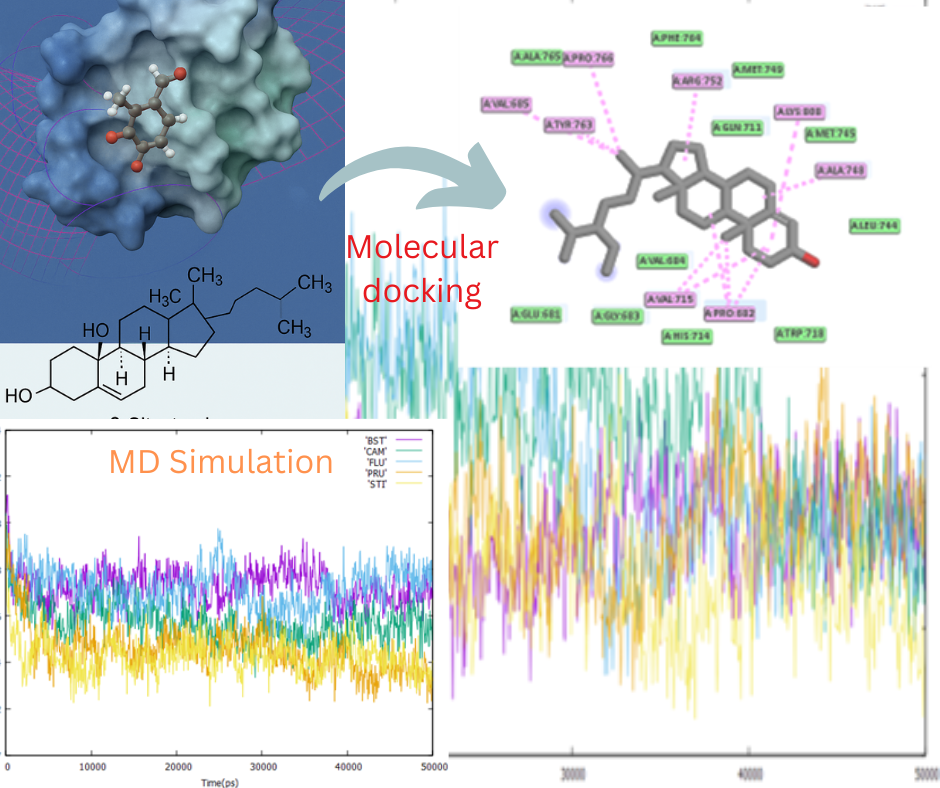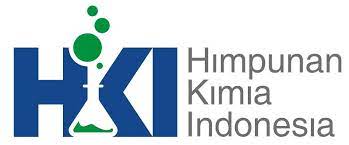
Screening, molecular docking and dynamic simulations of bioactive compounds from Prunus africana’s stem bark for potential prostate cancer inhibitors
Authors
Nnenna Winifred Odozi , Valentine OsiDOI:
10.29303/aca.v8i1.224Published:
2025-05-31Issue:
Vol. 8 No. 1 (2025)Keywords:
Androgen receptor Visual Screening, toxicological screening, Molecular Docking , Molecular DynamicsArticles
Downloads
How to Cite
Downloads
Metrics
Abstract
Prostate cancer is a major health problem for men, with few effective treatment choices. The growing interest in plant-based medicines needs more research into their safety and efficacy. In this study, twenty-seven (27) phytochemicals found in Prunus africana stem bark are evaluated using in silico methodologies such as toxicological and virtual screening, molecular docking, and molecular dynamics simulations. The PASS server projected that twenty (20) of these chemicals had anticancer properties. Molecular docking studies revealed that four bioactive compounds—β-Sitosterol (-8.9 kcal/mol), Campesterol (-8.7 kcal/mol), Prunetrin (-8.7 kcal/mol), and Stigmastan-3,5-diene (-8.7 kcal/mol)—have higher binding affinities than Flutamide (-8.6 kcal/mol), a commonly androgen receptor inhibitor. Further molecular dynamics simulations indicated that these compounds have comparable or greater stability than Flutamide. These data indicate that Prunus africana-derived phytochemicals could be viable candidates for prostate cancer treatment, necessitating further experimental validation.
References
Gotay, C. C., Holup, J. L., & Muraoka, M. Y. (2002). The challenges of prostate cancer: A major men's health issue. Int J Men's Health, 1(1), 59.
Rawla, P. (2019). Epidemiology of prostate cancer. World J Oncol, 10(2), 63.
Barsouk, A., Padala, S. A., Vakiti, A., Mohammed, A., Saginala, K., Thandra, K. C., ... & Barsouk, A. (2020). Epidemiology, staging and management of prostate cancer. Med Sci, 8(3), 28.
Gandaglia, G., Leni, R., Bray, F., Fleshner, N., Freedland, S. J., Kibel, A., ... & La Vecchia, C. (2021). Epidemiology and prevention of prostate cancer. Eur Urol Oncol, 4(6), 877-892.
Culp, M. B., Soerjomataram, I., Efstathiou, J. A., Bray, F., & Jemal, A. (2020). Recent global patterns in prostate cancer incidence and mortality rates. Eur Urol, 77(1), 38-52.
Ballentine Carter, H., & Coffey, D. S. (1990). The prostate: an increasing medical problem. The prostate, 16(1), 39-48.
Droz, J. P., Albrand, G., Gillessen, S., Hughes, S., Mottet, N., Oudard, S., ... & Aapro, M. (2017). Management of prostate cancer in elderly patients: recommendations of a task force of the International Society of Geriatric Oncology. Eur Urol, 72(4), 521-531.
Droz, J. P., Aapro, M., Balducci, L., Boyle, H., Van den Broeck, T., Cathcart, P., ... & Sugihara, T. (2014). Management of prostate cancer in older patients: updated recommendations of a working group of the International Society of Geriatric Oncology. Lancet Oncol, 15(9), e404-e414.
Nazim, S. M., Fawzy, M., Bach, C., & Ather, M. H. (2018). Multi-disciplinary and shared decision-making approach in the management of organ-confined prostate cancer. Arab J Urol, 16(4), 367-377.
Nazim, S. M., Fawzy, M., Bach, C., & Ather, M. H. (2018). Multi-disciplinary and shared decision-making approach in the management of organ-confined prostate cancer. Arab J. Urol., 16(4), 367-377.
Karantanos, T., Corn, P. G., & Thompson, T. C. (2013). Prostate cancer progression after androgen deprivation therapy: mechanisms of castrate resistance and novel therapeutic approaches. Oncogene, 32(49), 5501-5511.
Thomas, J., Beinhorn, C., Norton, D., Richardson, M., Sumler, S. S., & Frenkel, M. (2010). Managing radiation therapy side effects with complementary medicine. J. Soc. Integr. Oncol., 8(2), 65.
Dutta, S., Mahalanobish, S., Saha, S., Ghosh, S., & Sil, P. C. (2019). Natural products: An upcoming therapeutic approach to cancer. Food Chem. Toxicol., 128, 240-255.
Pan, S. Y., Litscher, G., Gao, S. H., Zhou, S. F., Yu, Z. L., Chen, H. Q., ... & Ko, K. M. (2014). Historical perspective of traditional indigenous medical practices: the current renaissance and conservation of herbal resources. Evid. Based Complement. Altern. Med., 2014.
Karunamoorthi, K., Jegajeevanram, K., Vijayalakshmi, J., & Mengistie, E. (2013). Traditional medicinal plants: a source of phytotherapeutic modality in resource-constrained health care settings. J. Evid. Based Complement. Altern. Med., 18(1), 67-74.
Priya, S., & Satheeshkumar, P. K. (2020). Natural products from plants: Recent developments in phytochemicals, phytopharmaceuticals, and plant-based nutraceuticals as anticancer agents. Funct. Preserv. Prop. Phytochem., 145-163.
Sendker, J., & Sheridan, H. (2017). History and current status of herbal medicines. Toxicol. Herb. Prod., 11-27.
Guo, R., Luo, X., Liu, J., Liu, L., Wang, X., & Lu, H. (2020). Omics strategies decipher therapeutic discoveries of traditional Chinese medicine against different diseases at multiple layers molecular-level. Pharmacol. Res., 152, 104627.
Sa, G., & Das, T. (2008). Anti-cancer effects of curcumin: cycle of life and death. Cell Div., 3, 1-14.
Rauf, A., Imran, M., Butt, M. S., Nadeem, M., Peters, D. G., & Mubarak, M. S. (2018). Resveratrol as an anti-cancer agent: A review. Crit. Rev. Food Sci. Nutr., 58(9), 1428-1447.
Rady, I., Mohamed, H., Rady, M., Siddiqui, I. A., & Mukhtar, H. (2018). Cancer preventive and therapeutic effects of EGCG, the major polyphenol in green tea. Egypt. J. Basic Appl. Sci., 5(1), 1-23.
Clarke, J. D., Dashwood, R. H., & Ho, E. (2008). Multi-targeted prevention of cancer by sulforaphane. Cancer Lett., 269(2), 291-304.
Samuel, S. M., Kubatka, P., & Büsselberg, D. (2021). Treating cancers using nature’s medicine: significance and challenges. Biomolecules, 11(11), 1698.
Liskova, A., Samec, M., Koklesova, L., Brockmueller, A., Zhai, K., Abdellatif, B., ... & Kubatka, P. (2021). Flavonoids as an effective sensitizer for anti-cancer therapy: Insights into multi-faceted mechanisms and applicability towards individualized patient profiles. EPMA J., 12(2), 155-176.
Macalino, S. J. Y., Gosu, V., Hong, S., & Choi, S. (2015). Role of computer-aided drug design in modern drug discovery. Arch. Pharm. Res., 38, 1686-1701.
Zhao, L., Ciallella, H. L., Aleksunes, L. M., & Zhu, H. (2020). Advancing computer-aided drug discovery (CADD) by big data and data-driven machine learning modeling. Drug Discov. Today, 25(9), 1624-1638.
Ejalonibu, M. A., Ogundare, S. A., Elrashedy, A. A., Ejalonibu, M. A., Lawal, M. M., Mhlongo, N. N., & Kumalo, H. M. (2021). Drug discovery for Mycobacterium tuberculosis using structure-based computer-aided drug design approach. Int. J. Mol. Sci., 22(24), 13259.
Salman, M. M., Al-Obaidi, Z., Kitchen, P., Loreto, A., Bill, R. M., & Wade-Martins, R. (2021). Advances in applying computer-aided drug design for neurodegenerative diseases. Int. J. Mol. Sci., 22(9), 4688.
Bodeker, G., van ‘t Klooster, C., & Weisbord, E. (2014). Prunus africana (Hook. f.) Kalkman: the overexploitation of a medicinal plant species and its legal context. J. Altern. Complement. Med., 20(11), 810-822.
Komakech, R., & Kang, Y. (2019). Ethnopharmacological potential of African cherry [Prunus africana]. J. Herb. Med., 17, 100283
Nambooze, J., Erukainure, O. L., & Chukwuma, C. I. (2022). Phytochemistry of Prunus africana and its therapeutic effect against prostate cancer. Comp. Clin. Pathol., 31(5), 875-893.
Madivoli, E. S., Maina, E. G., Kairigo, P. K., Murigi, M. K., Ogilo, J. K., Nyangau, J. O., ... & Kipyegon, C.
(2018). In vitro antioxidant and antimicrobial activity of Prunus africana (Hook. f.) Kalkman (bark extracts) and Harrisonia abyssinica Oliv. extracts (bark extracts): A comparative study. J. Med. Plants Econ. Dev., 2(1), 1-9.
Rubegeta, E., Makolo, F., Kamatou, G., Enslin, G., Chaudhary, S., Sandasi, M., ... & Viljoen, A. (2023). The African cherry: A review of the botany, traditional uses, phytochemistry, and biological activities of Prunus africana (Hook. f.) Kalkman. J. Ethnopharmacol., 305, 116004.
Asuzu, P. C. (2019). In vitro Assessment of Phytoconstituents, Efficacy and Cytotoxicity of Extracts from Medicinal Plants on Prostate Cancer C4-2 Cells. Delaware State University.
Asuzu, P. C., Trompeter, N. S., Cooper, C. R., Besong, S. A., & Aryee, A. N. (2022). Cell Culture-Based Assessment of Toxicity and Therapeutics of Phytochemical Antioxidants. Molecules, 27(3), 1087.
Nyamai, D. W., Mawia, A. M., Wambua, F. K., Njoroge, A., Matheri, F., Lagat, R., et al. (2015). Phytochemical profile of Prunus africana stem bark from Kenya. J. Pharmacogn. Nat. Prod., 1, 8.
Komakech, R., Kang, Y., Lee, J. H., & Omujal, F. (2017). A review of the potential of phytochemicals from Prunus africana (Hook f.) Kalkman stem bark for chemoprevention and chemotherapy of prostate cancer. Evid.-Based Complement. Alternat. Med., 2017.
Rahman, M., Talukder, A., & Akter, R. (2021). Computational designing and prediction of ADMET properties of four novel imidazole‐based drug candidates inhibiting heme oxygenase‐1 causing cancers. Mol. Inform., 40(10), 2060033.
Huggins, D. J., Sherman, W., & Tidor, B. (2012). Rational approaches to improving selectivity in drug design. J. Med. Chem., 55, 1424-1444.
Hughes, J. P., Rees, S., Kalindjian, S. B., & Philpott, K. L. (2011). Principles of early drug discovery. Br. J. Pharmacol., 162, 1239–1249.
Copeland, R. A. (2016). The drug–target residence time model: A 10-year retrospective. Nat. Rev. Drug Discov., 15, 87–95.
Abdizadeh, R., Hadizadeh, F., & Abdizadeh, T. (2022). In silico analysis and identification of antiviral coumarin derivatives against 3-chymotrypsin-like main protease of the novel coronavirus SARS-CoV-2. Mol. Divers., 26, 1053–1076.
Uzzaman, M., Shawon, J., & Siddique, Z. A. (2019). Molecular docking, dynamics simulation, and ADMET prediction of Acetaminophen and its modified derivatives based on quantum calculations. SN Appl. Sci., 1, 1–10.
Durojaye, O. A., Sedzro, D. M., Idris, M. O., Yekeen, A. A., Fadahunsi, A. A., & Alakanse, O. S. (2022). Identification of a potential mRNA‐based vaccine candidate against the SARS‐CoV‐2 spike glycoprotein: A reverse vaccinology approach. ChemSelect, 7, e202103903.
Adejoro, I. A., Babatunde, D. D., & Tolufashe, G. F. (2020). Molecular docking and dynamic simulations of some medicinal plant compounds against SARS-CoV-2: An in silico study. J. Taibah Univ. Sci., 14, 1563–1570.
Meanwell, N. A. (2011). Improving drug candidates by design: A focus on physicochemical properties as a means of improving compound disposition and safety. Chem. Res. Toxicol., 24, 1420–1456.
Mohamad Rosdi, M. N., Mohd Arif, S., Abu Bakar, M. H., Razali, S. A., Mohamed Zulkifli, R., & Ya’akob, H. (2018). Molecular docking studies of bioactive compounds from Annona muricata Linn as potential inhibitors for Bcl-2, Bcl-w, and Mcl-1 antiapoptotic proteins. Apoptosis, 23, 27–40.
Martin, Y. C., Kofron, J. L., & Traphagen, L. M. (2002). Do structurally similar molecules have similar biological activity? J. Med. Chem., 45, 4350–4358.
License
Copyright (c) 2025 Nnenna Winifred Odozi , Valentine Osi

This work is licensed under a Creative Commons Attribution-NonCommercial-ShareAlike 4.0 International License.
Authors who publish with ACA: Acta Chimica Asiana agree to the following terms:
- Authors retain copyright and grant the journal right of first publication with the work simultaneously licensed under a Creative Commons Attribution-NonCommercial-ShareAlike 4.0 International License. This license allows authors to use all articles, data sets, graphics, and appendices in data mining applications, search engines, web sites, blogs, and other platforms by providing an appropriate reference. The journal allows the author(s) to hold the copyright without restrictions and will retain publishing rights without restrictions.
- Authors are able to enter into separate, additional contractual arrangements for the non-exclusive distribution of the journal's published version of the work (e.g., post it to an institutional repository or publish it in a book), with an acknowledgement of its initial publication in ACA: Acta Chimica Asiana.
- Authors are permitted and encouraged to post their work online (e.g., in institutional repositories or on their website) prior to and during the submission process, as it can lead to productive exchanges, as well as earlier and greater citation of published work (See The Effect of Open Access).





 Indonesian Chemical Society, Chapter Nusa Tenggara. Jalan Majapahit 62 Mataram, University of Mataram, 83125, Indonesia
Indonesian Chemical Society, Chapter Nusa Tenggara. Jalan Majapahit 62 Mataram, University of Mataram, 83125, Indonesia





